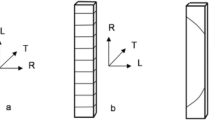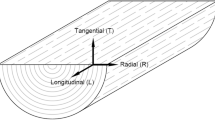Abstract
The effects of temperature and water content on the viscoelasticity of living and dehydrated Tilia americana sapwood were examined using transient creep (time- and load-dependent deformation) tests under sustained bending loads. Creep tests were performed at 21.1°C and –20.5°C to determine the magnitudes and types of strains in living and dehydrated samples. Temperature had no effect on the creep rate of living sapwood. However, the creep rate of dehydrated samples at –20.5°C was significantly faster than that at 21.1°C. Regardless of temperature, sapwood had a faster creep rate than dehydrated samples. With small bending loads, the residual strains in sapwood were larger at 21.1°C compared to –20.5°C. Temperature did not significantly affect the residual strains in dehydrated samples. For small bending loads, frozen sapwood recovered all residual creep strains when thawed. With larger loads, residual and plastic (permanent) strains increased. We speculate that ice formation in cell lumens partially dehydrates (and thus stiffens and strengthens) cell wall materials and prevents cell wall buckling and elastic restoration after unloading. However, when thawed, sapwood can elastically restore its original configuration, provided it is not excessively bent (by ice or snow accumulations) when frozen.




Similar content being viewed by others
References
Esau K (1977) Anatomy of seed plants. Wiley, New York
Gibson LJ, Ashby MF (1988) Cellular solids. Pergamon, Oxford
Gril J, Thibaut B, Berrada E, Martin G (1993a) Recouvrance hygrothermique du bois vert. I. Influence de la température. Cas du jujbier [ Ziziphus lotus (L) Lam]. Ann Sci For 50:57–70
Gril J, Berrada E, Thibaut B (1993b) Recouvrance hygrothermique du bois vert. II. Variations dans le plan transverse chez le châtaignier et l’épicèa et modélisation de la fissuration à coeur provoquée par l’étuvage. Ann Sci For 50:487–508
Gurfinkel G (1981) Wood engineering. Kendall/Hunt, Dubuque, Iowa
Holmberg S, Persson K, Petersson H (1999) Nonlinear mechanical behavior and analysis of wood and fibre materials. Comp Struct 72:459–480
Hunt DG (1999) A unified approach to creep of wood. Proc R Soc London Ser A 455:4077–4095
Jeronimidis G (1976) The work of fracture of wood in relation to its structure. In: Baas P, Bolton AJ, Catling DM (eds) Wood structure in biological and technological research. Leiden Botanical Series 3. Leiden University Press, Leiden, pp 253–265
Jeronimidis G (1980) The fracture behavior of wood and the relations between toughness and morphology. Proc R Soc London Ser B 208:447–460
Kliger IR, Pellicane PJ (1996) Time-dependent bending properties of lumber. J Test Eval 24:187–193
Köhler L, Spatz H-C (2002) Micromechanics of plant tissues beyond the linear-elastic range. Planta 215:33–40
Körber C, Scheiwe MW (1983) Observations on the non-planar freezing of aqueous salt solutions. J Crystal Growth 61:307–316
Maloney TC, Paulpuro H, Stenius P (1998) Hydration and swelling of pulp fibres measured with differential scanning calorimetry. Nordic Pulp Paper Res 13:31–36
Mark RE (1967) Cell wall mechanics of tracheids. Yale University Press, New Haven
Mårtensson A (1994) Creep behavior of structural timber under varying humidity conditions. J Struct Eng 120:2565–2582
Navi P, Pittet V, Plummer CJG (2002) Transient moisture effects on wood creep. Wood Sci Technol 36:447–462
Niklas KJ (1989a) Mechanical behavior of plant tissues as inferred from the theory of pressurized cellular solids. Am J Bot 76:929–937
Niklas KJ (1989b) Extracellular freezing in Equisetum hymale. Am J Bot 76:627–631
Niklas KJ (1992) Plant biomechanics. University of Chicago Press, Chicago, Ill.
Robson DJ, Petty JA (1993) Freezing and thawing in conifer xylem. In: Borghetti M, Grace J, Raschi A (eds) Water transport in plants under climatic stress. Cambridge University Press, New York, pp 75–85
Sakai A (1982) Extraorgan freezing of primordial shoots of winter buds of conifers. In: Li PH, Sakai A (eds) Plant cold hardiness and freezing stress. Academic Press, New York, pp. 199–209
Sparks JP, Campbell GS, Black RA (2001) Water content, hydraulic conductivity, and ice formation in winter stems of Pinus contorta: a TDR case study. Oecologia 127:468–475
Steponkus P (1984) Role of plasma membrane in freezing injury and cold acclimation. Annu Rev Plant Physiol 35:543–584
Sucoff E (1969) Freezing of conifer xylem and the cohesion tension theory. Physiol Plant 22:424–431
Vincent J (1990) Structural biomaterials. Princeton University Press, Princeton, N.J.
Zweifel R, Häsler R (2000) Frost-induced reversible shrinkage of bark of mature subalpine conifers. Agric For Meteorol 102:213–222
Acknowledgements
We thank James A. Bartsch (Cornell University) for providing access to the Instron testing machine. We also thank Ingo Burgert (University of Agricultural Sciences, Vienna), Anthony R. Ennos (University of Manchester, England), George Jeronimidis (University of Reading, England), Hanns-Christof Spatz (University of Freiburg, Germany), and Thomas Speck (University of Freiburg, Germany) who reviewed and commented on an early draft of this paper. Funding was provided by the College of Agriculture and Life Sciences (to K.J.N.) and CALS Charitable Trust and Morley research grants (to C.J.H.).
Author information
Authors and Affiliations
Corresponding author
Rights and permissions
About this article
Cite this article
Hogan, C.J., Niklas, K.J. Temperature and water content effects on the viscoelastic behavior of Tilia americana (Tiliaceae) sapwood. Trees 18, 339–345 (2004). https://doi.org/10.1007/s00468-003-0311-x
Received:
Accepted:
Published:
Issue Date:
DOI: https://doi.org/10.1007/s00468-003-0311-x




